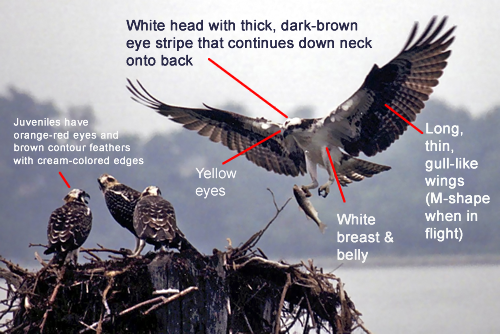How to identify an osprey
The osprey is one of the largest birds of prey in North America. On average, females weigh about 15–20% more than males, and are 5–10% longer in wing, tail, claw, and bill length.
 Length
Length
52-60cm (20.5-23.6 inches)
Wingspan
150-180 centimeters (5-6 feet)
Weight
1,400 to 2,000 grams (3 - 4.4 pounds)Coloration
Generally white below and brown above. White belly and throat; breast is mostly white with some brown mottling. Back and upper surface of wings are dark chocolate-brown. Crown and forehead are also white with brown streak that runs from the beak, around the eye, and to the nape. Iris of adult is yellow. Beak is black and sharply curved. Upper tail is dark brown with paler bands; under tail is barred with gray. "Necklace" of brown spots across breast is more pronounced in females, which also tend to have darker heads than males. Juveniles are similar to adults, but with orange eyes and whitish mottling on back feathers.
Bearing
Wings are long and narrow, with distinctive bend at "wrists" so that wingtips angle slightly backwards. Four "finger" feathers at the end of each wing are distinctive.
Notes
The osprey is well adapted to its diet, with reversible outer toes to hold captured fish securely during flight, closable nostrils to exclude water during dives, and spiny pads on the talons to help catch fish.
Call
A series of sharp "kee, kee, kee." Near the nest, a frenzied cheereek!
Similar To
Not easily confused with other birds of prey, except perhaps the adult Bald Eagle (Haliaeetus leucocephalus), which is larger, with all white head and tail. In flight, possibly confused at a distance with large gulls, especially adult Great Black-backed Gull (Larus marinus), but latter has all white head and tail, longer bill, white trailing edge to wing, and no crook to wings.
